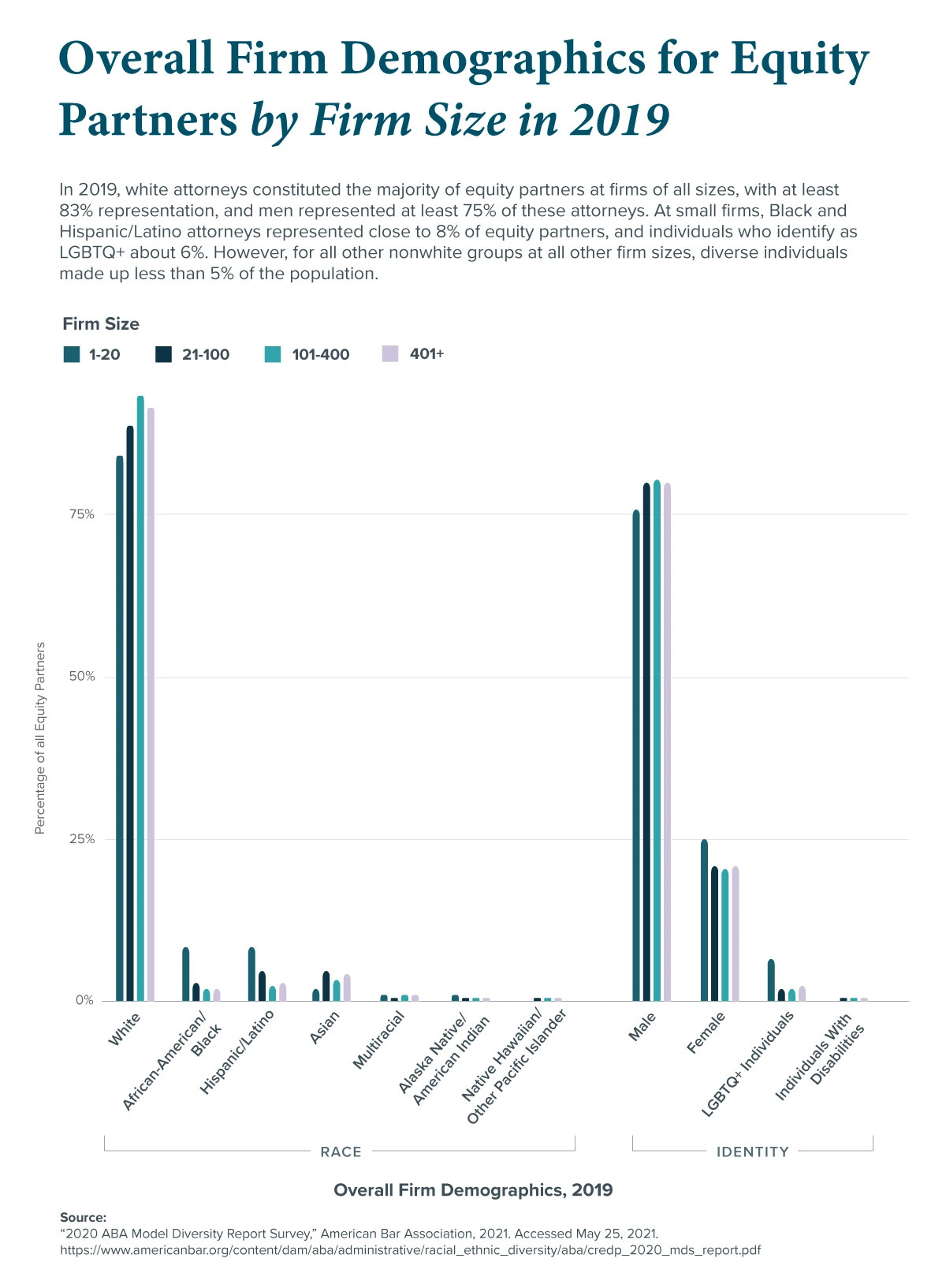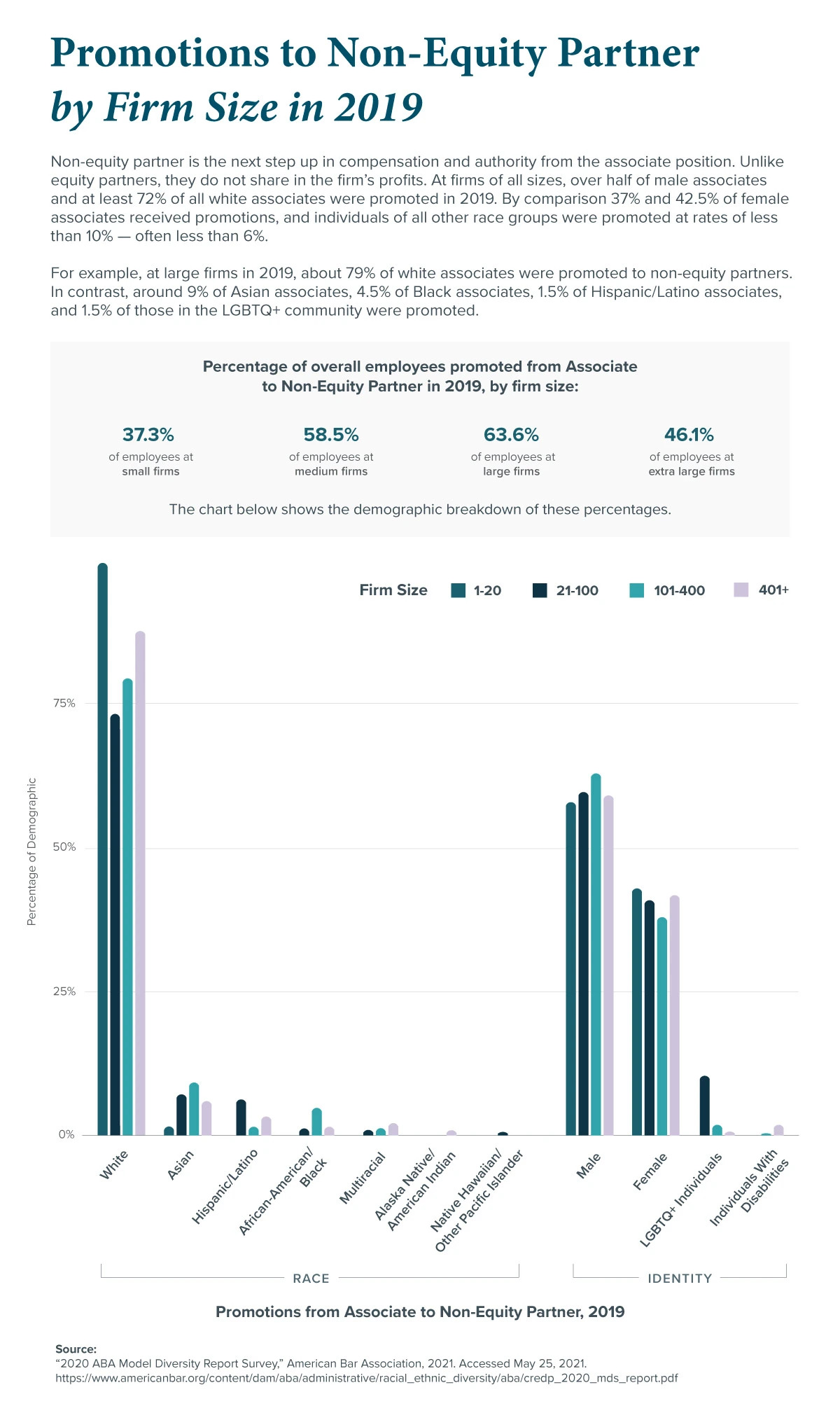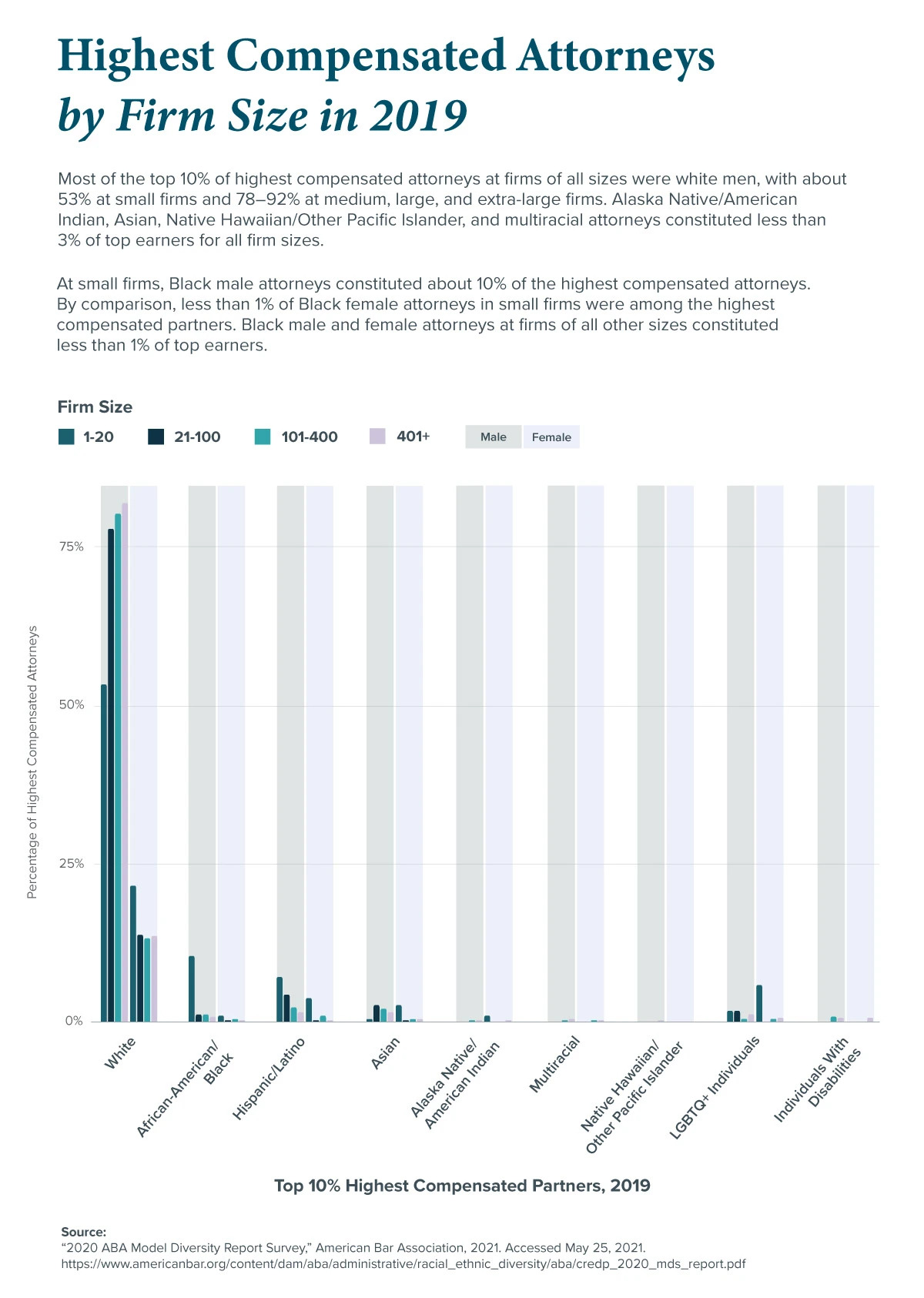Minorities in Legal Education

Diversity and inclusion continue to be challenges for the legal profession, according to the National Association for Law Placement’s Report on Diversity (PDF, 1.6 MB). Lack of diversity spans across a variety of categories, including gender, race, sexual orientation and disability.
This collection of resources highlights support systems to help students from diverse backgrounds seeking a legal education, such as Juris Doctor (J.D.) or Master of Legal Studies (MLS), as well as guidance for legal organization leaders to support diversity and inclusion.
The Current State of Diversity in the Legal Profession
In 2021, the American Bar Association released its Diversity Model Survey Report, the first report on diversity, equity and inclusion in law firm practice. The survey captured three years of data at firms of various sizes:
- Small: 1–20 attorneys
- Medium: 21–100 attorneys
- Large: 101–400 attorneys
- Extra-Large: 401+
Overall Firm Demographics for Equality Partners by Firm Size in 2019

Promotions to Non-Equity Partner by Firm Size in 2019

Highest Compensated Attorneys by Firm Size in 2019

Resources for Prospective and Current Law Students
To become a lawyer, individuals must apply to, attend and graduate from an accredited Juris Doctor (J.D.) program. Prospective and current students can leverage resources from a variety of diversity organizations to be successful in their education.
Diversity Scholarships for Law Students
American Bar Association (ABA): Diversity Scholarships
The ABA scholarship page includes information on many diversity scholarships for law students offered by external sources. Opportunities include diversity scholarships open to all populations that are underrepresented in the legal field, as well as scholarships for specific populations, such as law students with disabilities.
ABA for Law Students: Scholarships and Financial Aid
The ABA for Law Students scholarship page includes a section dedicated to diversity scholarships. There is also general information on financial aid and resources for law students with special needs.
Council on Legal Education Opportunity: Financial Aid Resources
CLEO “is committed to helping students from underrepresented backgrounds enter the legal profession” and provides a list of scholarships and financial aid resources for law students. While many of the opportunities listed are available to all law students, this resource page focuses on helping students from diverse populations prepare for the cost of their education.
Law School Admission Council: Diversity Scholarships
LSAC offers a resource page for students “from diverse racial and ethnic backgrounds” that includes scholarships from external organizations, summer prelaw programs and other opportunities for new and returning law students.
Law Student Associations and Organizations
The Council on Legal Education Opportunity
CLEO is a national organization focused on expanding opportunities for law students from underrepresented backgrounds and those in need of financial assistance. They offer a variety of resources, including the Prelaw Summer Institute, their flagship program “designed to familiarize and better prepare students to succeed in law school.”
This coalition of Latino students seeks to advance Latinos in the legal profession through networking, events and an annual conference where students and attorneys can discuss issues facing the Latino community.
North American South Asian Law Students Association
Established in 1997, NASALSA is “dedicated to creating a strong network and community among South Asian law students and legal professionals throughout the United States and Canada.” The nonprofit offers a mentorship program, events and other resources to help South Asian law students pursue a career in the legal field.
National Black Law Student Association
NBLSA aims to “promote the educational, professional, political and social needs and goals of Black law students.” This includes providing learning opportunities for members and addressing concerns of the Black community to bring about legal and political change.
National Latina/o Law Student Association
NLLSA was “founded on principles of social, ethnic, racial, gender and sexual equality,” and aims to empower Latino and Latina law students through academic success and community service. The nonprofit facilitates student-led conferences and events and brings issues affecting Latino and Hispanic communities to light.
National Native American Law Students Association
Founded in 1970, NNALSA supports law students “interested in the study of Federal Indian Law, Tribal Law and traditional forms of governance.” In addition to supporting Native American law students, the organization strives to promote Indigenous legal issues.
Diversity Resources for Legal Professionals
Members of diverse populations who work in all areas of law may face additional challenges than other lawyers. Joining a professional organization that focuses on diversity can help them find support and resources and engage in networking opportunities.
Legal Professional Organizations
Corporate Counsel Women of Color
Formed in 2004, CCWC is a professional organization of women of color “who serve as general counsel, assistant general counsel, corporate counsel, in-house legal counsel and in other capacities for Fortune 1000 companies, Forbes 2000 companies, not-for-profit corporations” and other organizations. CCWC aims to help women attorneys of color advance their careers and promote diversity in the legal field.
Hispanic National Bar Association
HNBA is a national nonprofit representing the interests of Hispanic legal professionals in the United States and its territories. Established in 1972, HNBA strives to be “more than a bar organization” by focusing on advocacy on issues that affect Hispanic communities in addition to providing professional support to members.
Leadership Council on Legal Diversity
Made up of more than 320 corporate chief legal officers and law firm managing partners, this organization works to build an open and diverse legal profession through its programs and resources.
Minority Corporate Counsel Association
The MCCA provides recommended practices for law firms to increase their diversity with statistics, interviews and best practices for law firms to advance “the hiring, retention and promotion of diverse lawyers.”
National Asian Pacific American Bar Association
NAPABA is a professional organization for the Asian and Pacific American legal community that works to increase and support its members through membership, events, advocacy and research.
National Association of Minority and Women Owned Law Firms
NAMWOLF is a nonprofit trade association of law firms owned by women, minorities and other interested parties in the United States. It serves members through Practice Area Committees, inclusion and diversity initiatives, events and more.
National Association of Women Lawyers
NAWL aims to “provide leadership, a collective voice and essential resources to advance women in the legal profession and advocate for the equality of women under the law.” The organization provides national and regional year-round programming, networking and leadership opportunities to empower women in the legal field.
The LGBT Bar “promotes justice in and through the legal profession for the LGBTQ+ community in all its diversity.” Founded more than 30 years ago, the LGBT Bar became an official affiliate of the ABA in 1992. The association includes lawyers, judges, law students, activists and affiliated LGBTQ+ legal organizations.
National Native American Bar Association
NNABA is an organization of attorneys who are U.S. citizens and citizens of their respective Tribal nations and who work to protect the governmental sovereignty of the more than 560 independent Tribal governments in the United States.
South Asian Bar Association of North America
SABA provides the South Asian legal community with a forum for professional growth and advancement and works to “promote equal rights and access to justice for the South Asian community.” Members can engage in advocacy, attend events, access resources and participate in regional chapters of the association.
Diversity Resources and Further Reading for Leaders of Legal Organizations
- 2Civility: It’s Time to Remove Professional Barriers for Lawyers With Disabilities
- American Bar Association’s Diversity and Inclusion Center
- The Association of Legal Administrators Diversity Toolkit
- The Business of Inclusion: Raising the Bar on LGBT Diversity (PDF, 351 KB)
- Center for Legal Inclusiveness: Education
- Minority Corporate Counsel Association’s Sustaining Pathways to Diversity Research Reports
- Out Leadership: Insights
The following section contains tabular data from the graphics in this post.
Overall Firm Demographics for Equity Partners by Firm Size in 2019
| Demographic | Firm Size 1-20 | Firm Size 21-100 | Firm Size 101-400 | Firm Size 401+ |
|---|---|---|---|---|
African-American/Black | 7.88% | 2.47% | 1.47% | 1.86% |
Hispanic/Latino | 7.88% | 4.35% | 1.89% | 2.41% |
Alaska Native/American Indian | 0.76% | 0.18% | 0.08% | 0.12% |
Asian | 1.82% | 4.48% | 2.87% | 3.77% |
Native Hawaiian/Other Pacific Islander | 0.00% | 0.04% | 0.09% | 0.06% |
Multiracial | 0.81% | 0.07% | 0.59% | 0.65% |
White | 83.57% | 88.24% | 92.81% | 90.83% |
Female | 24.75% | 20.69% | 20.05% | 20.51% |
Male | 75.25% | 79.31% | 79.95% | 79.49% |
LGBTQ+ | 6.31% | 1.69% | 1.65% | 2.15% |
Disability Status | 0.00% | 0.13% | 0.38% | 0.45% |
Source: “2020 ABA Model Diversity Report Survey,” American Bar Association, 2021. Accessed May 25, 2021.
Back to “Overall Firm Demographics for Equality Partners by Firm Size in 2019” graphic
Promotions from Associate to Non-Equity Partner in 2019
| Demographic | Firm Size 1-20 | Firm Size 21-100 | Firm Size 101-400 | Firm Size 401+ |
|---|---|---|---|---|
OVERALL | 37.36% | 58.46% | 63.57% | 46.05% |
African-American/Black | 0.00% | 1.07% | 4.63% | 1.40% |
Hispanic/Latino | 0.00% | 6.00% | 1.41% | 2.98% |
Alaska Native/American Indian | 0.00% | 0.00% | 0.00% | 0.73% |
Asian | 1.25% | 7.00% | 9.10% | 5.78% |
Native Hawaiian/Other Pacific Islander | 0.00% | 0.40% | 0.00% | 0.00% |
Multiracial | 0.00% | 0.80% | 1.07% | 1.82% |
White | 98.75% | 72.73% | 78.92% | 87.14% |
Female | 42.50% | 40.60% | 37.54% | 41.43% |
Male | 57.50% | 59.40% | 62.46% | 58.57% |
LGBTQ+ | 0.00% | 10.13% | 1.54% | 0.56% |
Disability Status | 0.00% | 0.00% | 0.14% | 1.58% |
Source: “2020 ABA Model Diversity Report Survey,” American Bar Association, 2021. Accessed May 25, 2021.
Back to “Promotions to Non-Equity Partner by Firm Size in 2019” graphic
Highest Compensated Attorneys by Firm Size in 2019
| Demographic | Firm Size 1-20 | Firm Size 21-100 | Firm Size 101-400 | Firm Size 401+ |
|---|---|---|---|---|
African-American/Black Males | 10.38% | 0.98% | 0.95% | 0.75% |
African-American/Black Females | 0.82% | 0.20% | 0.31% | 0.19% |
Hispanic/Latino Males | 6.97% | 4.22% | 2.08% | 1.41% |
Hispanic/Latina Females | 3.69% | 0.20% | 0.84% | 0.11% |
Alaska Native/American Indian Males | 0.00% | 0.00% | 0.13% | 0.06% |
Alaska Native/American Indian Females | 0.82% | 0.00% | 0.00% | 0.08% |
Asian Males | 0.23% | 2.61% | 2.02% | 1.38% |
Asian Females | 2.46% | 0.20% | 0.30% | 0.23% |
Native Hawaiian/Other Pacific Islander Males | 0.00% | 0.00% | 0.00% | 0.10% |
Native Hawaiian/Other Pacific Islander Females | 0.00% | 0.00% | 0.00% | 0.00% |
Multiracial Males | 0.00% | 0.00% | 0.07% | 0.29% |
Multiracial Females | 0.00% | 0.80% | 0.03% | 0.07% |
White Males | 53.26% | 77.91% | 80.29% | 81.90% |
White Females | 21.37% | 13.69% | 12.99% | 13.43% |
LGBTQ+ Males | 1.64% | 1.63% | 0.26% | 1.06% |
LGBTQ+ Females | 5.74% | 0.00% | 0.33% | 0.46% |
Males with Disabilities | 0.00% | 0.00% | 0.60% | 0.54% |
Females with Disabilities | 0.00% | 0.00% | 0.00% | 0.18% |
Source: “2020 ABA Model Diversity Report Survey,” American Bar Association, 2021. Accessed May 25, 2021.
Back to Highest Compensated Attorneys by Firm Size in 2019 graphic

